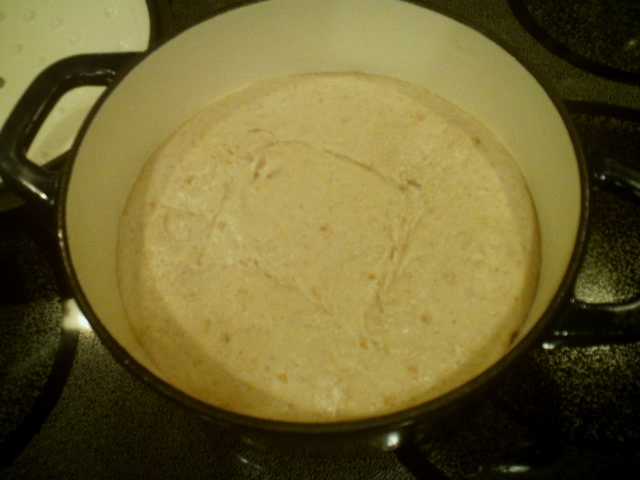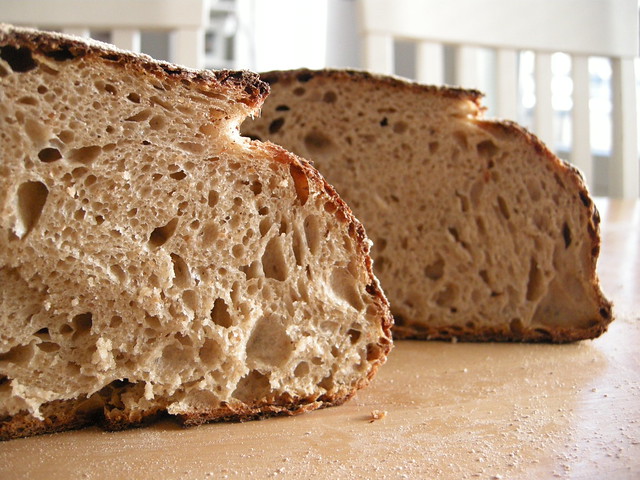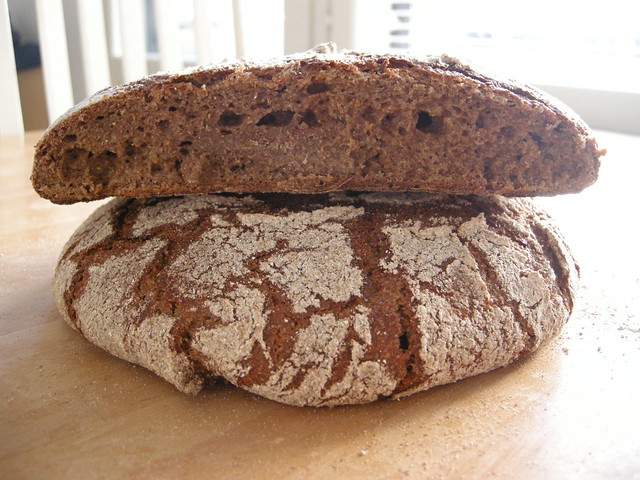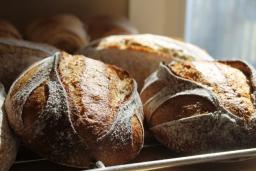Here is an everyday Tartine method DO sourdough with 30% rye, WW, bulgar and farro in the levine, boilded soaker and dough.
This loaf was only retarded 4 hours. The cold DO was placed in a 500 F oven. The spring was about 75% in the DO after 20 minutes c0vered. The bread was then baked at 425 F convection oven uncovered for 10 minutes and then the bread was taken out of the DO and placed on the stone and baked until the internal temperature was 205 F. It was then left in the off oven with the door ajar for 12 minutes to further crisp the crust. The crust was dark and crisp. The crumb came out light, airy, soft moist and moderately open with the cracked berries coming through. The taste is its best quality with a medium sour note. This will make a nice sandwich loaf. Recipe follows Pix's






Everyday Rustic Country Sourdough
Yield: one 850 g Loaf
Ingredients
Levain Build
50 g KA AP flour
25 g Whole wheat flour
25 g Whole rye flour
75 g water, cool (60 For so)
25 g active starter (100% hydration)
Boiled Soaker
10 g rye berries cracked
10 g WW berries cracked
10 g farro
10 g bulgar
Final Dough (77% hydration, including levain excluding the soaker)
25 g rye
25 g whole wheat
15 g bulgar
15 g farro
170 g KA AP flour
170 g KA bread flour
325 g warm water (80 For so)
1 tsp barely malt syrup
8 gpink Himalayan sea salt (1.5%)
Boil and Soak – soaker ingredients in twice as much water by volume. Bring to a boil and turn off heat and let soak until cool.
Directions
1. Levain : Make the final build 10-12 hours before the final mix.
2. Mix: Add all the ingredients to the mixing bowl, including the levain, but not the salt or the soaker. Mix just until the ingredients are incorporated into a shaggy mass. Correct the hydration as necessary. Cover the bowl and let stand for an autolyse phase of 60 minutes. At the end of the autolyse, sprinkle the salt over the surface of the dough, and knead 8 minutes with dough hook on KA 3. The dough should have a medium consistency. Add the scalded and caramelized berries and mix on KA 3 for 1 minute
3. Ferment with S&F: 2 hours. Stretch and fold the dough in the bowl 4 strokes at 15 minute intervals for 1 hour. Stretch and fold again, 4 strokes, at the one hour mark folding it into a ball in lightly oiled bowl. Do 1 S &F two more times at 90 and 120 minutes. Form into ball stretching the skin tight and place in floured benetton or shape into a batard leave to ferment 1-2 more hours until the dough is at least 75% larger than when you started the ferment. Remove from bennetton and bake as below.
If doing DO Tartine method form into ball and place in DO for final rise and bake as below.
4. If retarding: do 1 S&F in the lightly oiled bowl forming the dough into a ball again. Refrigerate 8-20 hours, depending on how much time you have and sour your taste.
5. Take dough out of refrigerator and let it come to room temperature about 1 ½ hours. Pre-shape, then shape into boules or batards 20 minutes later. OR, if doing Tartine method, form into ball and place into cast iron DO for final proof. Bake as below.
6. Proof: Approximately 1.5 to 2.5 hours at 82 F. Ready when poke test dictates.
7. Pre-heat: oven to 500 with steam apparatus in place - 45 minutes minimum. I use a loaf pan half full of water and a dry 12”cast iron skillet that go in the bottom rack of the oven at the beginning of pre heat and the stone on the rack above. When the loaf goes in, throw 1 cup of boiling water into the cast iron skillet right after loading the bread on the stone.
8. Bake: Do not slash loaf. Bake seam side up on stone at500 Ffor 5 minutes, turn down temperature to 450 F and bake for another 10 minutes. Remove steaming apparatus after 15 minutes. Turn down oven to425 Fconvection now and bake 15 minutes more, turning loaf every 5 minutes for browning evenness as necessary. When done (205 F internal temp), leave loaf on stone with oven door ajar, oven off for 10 minutes. Move to cooling rack until loaf is room temperature.
If doing DO, Bake at 20 minutes at500 Fremove lid and turn down oven to 425 F convection and bake for 10 minutes. Remove from DO and place on stone to bake until loaf is205 Fon the inside. Turn off oven, keep door ajar and let loaf rest on the stone for 12 minutes before removing to cooling rack.
















